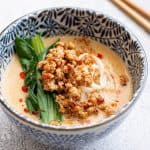Print
Tantanmen - Japanese Tan Tan Noodles
Creamy Tantanmen Ramen is a Japanese take on a classic Sichuan noodle dish. Chewy ramen noodles meet a nutty sesame broth and spicy pork, ready to eat in just 10 minutes.
Servings 2 serves
Calories 613kcal
Cost $10
Ingredients
- 150 g ramen noodles 5.2oz, fresh, or 50-100g / 1.7-3.5oz dried
Soup Paste:
- 2 tbsp tahini sub with Chinese sesame paste or peanut butter
- 1.5 tbsp soy sauce
- 1 tsp vinegar
- 2 tsp rayu chilli oil sub with sesame oil and a sprinkling of chilli powder to taste
Soup Stock:
- 250 ml chicken stock
- 125 ml soy milk
Pork Mince:
- 1 tbsp vegetable oil
- 200 g pork mince
- 1.5 tsp garlic chopped
- 1.5 tsp ginger chopped
- 1 tbsp doubanjiang sub with tian mian jiang (sweet bean paste) or gochujang
- 1 tbsp soy sauce
- 2 tsp sake sub with Chinese cooking wine or dry white wine
Veggies:
- 1 bok choy small, quartered or chopped
Optional toppings
Instructions
Pork Mince
- Heat the vegetable oil in a frypan. Add garlic and ginger, fry until fragrant (around 30 secs to 1 minute). Add the pork mince and fry until browned. For crispier pork, keep cooking until darker. Add doubanjiang, soy sauce and sake, and cook on low-medium heat until the liquid has fully absorbed.1.5 tbsp soy sauce, 1 tbsp vegetable oil, 200 g pork mince, 1.5 tsp garlic, 1.5 tsp ginger, 1 tbsp doubanjiang, 2 tsp sake, 1 tbsp soy sauce
Soup Paste
- Mix together tahini, soy sauce, vinegar and rayu chilli oil in a small bowl. Divide into two serving bowls.2 tbsp tahini, 1.5 tbsp soy sauce, 1 tsp vinegar, 2 tsp rayu chilli oil
Soup Base, Green Veggies & Noodles
- Add the chicken stock and soy milk into a medium saucepan, bring to the boil then turn off the heat.250 ml chicken stock, 125 ml soy milk
- Meanwhile bring a second saucepan of water to the boil. Add bok choy stems and blanch for 10-20 seconds, then add the leafy sections and blanch until wilted. Remove from the water and set aside, then add ramen noodles into the same water and cook according to packet directions. Drain.1 bok choy, 150 g ramen noodles
- Pour the soup broth into each bowl. Top with cooked ramen noodles, fried mince and blanched bok choy. Optional: Garnish with sesame oil, rayu chilli oil and sliced spring onion.sesame oil, rayu chilli oil, spring onion
Notes
- Blanching – For bok choy, boil the firm stalks first for 10 to 20 seconds in a pot of boiling water and then add the leafy parts.
- Noodles – These can be cooked in the same water as the bok choy to save dishes (and time). Cook them according to packet directions.
- Pork – For a delicious texture as well as flavour, fry the pork until dark and crispy.
- Broth – This may separate a bit when you add the hot noodles into the bowl. It’s totally okay. Stir it all through and it will reincorporate.
- Make it More or Less Spicy – Amp up or tone down the heat by using more or less rayu chilli oil and doubanjiang.
- Optional Garnishes – Top with crushed peanuts, spring onion, ramen eggs (ajitama), fried shallots, zha cai pickled greens or bean sprouts. Add some red pickled ginger (beni shoga) for a zingy burst of refreshing flavour. We also love it with a scattering of shichimi togarashi, toasted sesame seeds or gomashio sesame salt.
- Epic Additions – Serve your finished tantanmen with chicken karaage, nanban or tonkatsu pork cutlet.
- Can’t Find Doubanjiang? – Make a quick homemade version from 1 tbsp red miso, ½ tsp sugar, ½ tsp soy sauce and ½ tsp sesame oil. This amount is suitable for the recipe below (2 servings) so scale this up if you need to serve more people.
- Separate Noodles – Try it tsukemen style by dipping the ramen noodles into the broth, then slurping them up!
Nutrition
Calories: 613kcal | Carbohydrates: 24g | Protein: 34g | Fat: 44g | Saturated Fat: 16g | Cholesterol: 76mg | Sodium: 1994mg | Potassium: 1681mg | Fiber: 6g | Sugar: 10g | Vitamin A: 19011IU | Vitamin C: 195mg | Calcium: 564mg | Iron: 6mg
